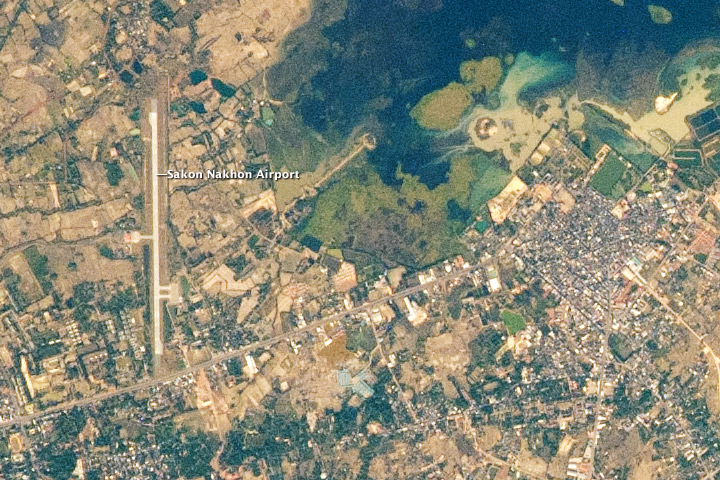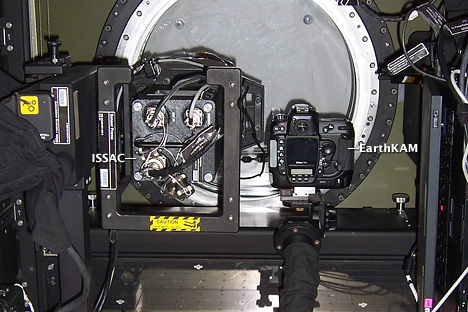

Following the British Columbia test images, the first student images were taken by Parkview Montessori in Jackson-Madison County, Tennessee, and by Public School 229–Dyker in Brooklyn, New York. Teacher Vickie LeCroy’s students at Parkview plan to study landforms such as islands, mountains, and deserts in the EarthKAM image they obtained of Mexico. Dyker teacher Camille Fratantoni and her students plan to enrich their studies of Earth Science and learn more about NASA missions.
After the first two days, EarthKAM ground controllers worked with Expedition 26 astronaut Cady Coleman to swap from a 50 millimeter (f1.4) lens to a 180 mm (f2.8) lens, in order to capture images with finer detail. Soon students from 146 participating schools captured 1,023 more images (1,562 total).
“The clarity and level of detail is captivating,” said Brion Au, EarthKAM payload developer. “Never before in the history of EarthKAM have images of this quality been possible.”


Photograph and zoomed enlargement of That Choeng Shum, Thailand. (EarthKAM Winter 2011 Mission Image 59371.)
An image of That Choeng Shum, Thailand—taken on January 21, 2011—demonstrates the clarity of images taken through the Destiny lab window and WORF. The view is so crisp that details such as the stripes (about 6 meters wide) on the Sakon Hakhon runway are faintly visible.
The new combination of the Destiny lab window and the WORF adds to the space station’s capabilities as a remote-sensing platform for Earth science. It enables the operation of high-resolution cameras and multi- or hyperspectral imagers within the pressurized environment of the ISS. And the WORF/Optical Window tandem also can be used for research and applications in fields such as geology, volcanology, meteorology, oceanography, coastal ocean management, ranch and forestry management, and disaster assessments and management.
In this capacity, the ISS can be used not only as a test bed for new instruments, but as an operating location for current sensor technology without the space environment and platform design requirements necessary for “free-flyer” orbital sensors.

In a mockup (testbed) version of the WORF and Destiny Laboratory window at NASA Johnson Space Center, the ISSAC (left) and EarthKAM (right) are installed on the stable payload shelf. (NASA photograph courtesy Johnson Space Center.)
Currently, both the EarthKAM and the ISS Agricultural Camera (ISSAC) are onboard the ISS. EarthKAM is operational now, while ISSAC will become operational in the spring of 2011, when both payloads will conduct simultaneous but independent operations—the first time multiple payloads would be operational in the WORF for Earth science.
ISS EarthKAM photograph Winter 2011 Mission Image 9362 was acquired on January 17, 2011, with a Nikon D2Xs digital camera fitted with a 50 mm lens. ISS EarthKAM photograph Winter 2011 Mission Image 59371 was acquired on January 21, 2011, with a Nikon D2Xs digital camera fitted with a 180 mm lens. Both images are provided by the ISS Crew Earth Observations experiment and the Image Science & Analysis Laboratory, Johnson Space Center. The EarthKAM payload was set up by Expedition 26 crew member Cady Coleman. EarthKAM ground controllers took both images. The images in this article have been cropped and enhanced to improve contrast. The International Space Station Program provides integration for payloads such as EarthKAM as part of the ISS National Lab. Also, images taken by astronauts and cosmonauts can be viewed at the NASA/JSC Gateway to Astronaut Photography of Earth.